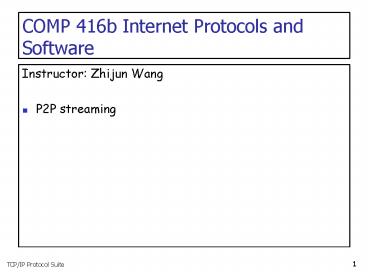COMP 416b Internet Protocols and Software - PowerPoint PPT Presentation
1 / 16
Title:
COMP 416b Internet Protocols and Software
Description:
BitTorrent (BT) Released in the summer of 2001 by Bram Cohen. ... 2006, the PPLive network provided 200 channels with 400,000 daily users on average. ... – PowerPoint PPT presentation
Number of Views:38
Avg rating:3.0/5.0
Title: COMP 416b Internet Protocols and Software
1
COMP 416b Internet Protocols and Software
- Instructor Zhijun Wang
- P2P streaming
2
BitTorrent (BT)
- Released in the summer of 2001 by Bram Cohen.
- P2P application that capitalizes the resources
(disk storage bandwidth) for effective large
files distribution. - Unlike Kazaa/Gnutella which thrive to quickly
locate a file, BitTorrents objective is to
quickly replicate a file to clients. - Uses basic ideas from game theory to largely
eliminate the free-rider problem. - Working extremely well.
3
Basic concepts of BT
- Seed A peer that has the entire file.
- Leecher A peer that has incomplete copy of the
file. - A .torrent file.
- Passive component
- Lists a SHA1 hash to verify integrity of files
- Typically hosted on a web server
- A Tracker
- Active component
- Allows peers to find each other
- Returns a random list of peers connected
4
Swarming Pieces and Sub-pieces
- A piece, typically 256KB is broken into 16KB
sub-pieces. - Until a piece is assembled, only sub-pieces for
that piece is downloaded. - This ensures that complete pieces assemble
quickly. - When transferring data over TCP, it is critical
to always have several requests pending at once,
to avoid a delay between pieces being sent. - At any point in time, some number, typically 5,
are requested simultaneously. - On piece completion, notify all peers.
5
Pieces selection
- The order of pieces is very important for good
performance. - A bad algorithm could result in all peers waiting
for the same missing piece. - Random Piece First policy
- Initially a peer had no pieces to trade, thus
important to get a piece ASAP. - Policy Peer starts with a random piece to
download. - Rarest Piece First policy
- Policy Download the pieces which are most rare
among your peers. - Ensures most common pieces are left for last.
6
Rarest First Policy
Peer
12,7,36
12,7,14
Peer
. . .
Peer
14
7
Topology P2P streaming system
- Tree topology
Server
Peers are arranged as a tree. A peer download the
data from its parent.
8
Topology P2P streaming system
- Mesh topology
Server
A peer can download data from its neighbors. No
single point failure.
9
IPTV system
- PPLive free P2P-based IPTV
- As of January 2006, the PPLive network provided
200 channels with 400,000 daily users on
average. - The bit rates of video programs mainly range from
250 Kbps to 400 Kbps with a few channels as high
as 800 Kbps. - The video content is mostly feeds from TV
channels in Mandarin. - The channels are encoded in two video formats
Window Media Video (WMV) or Real Video (RMVB). - The encoded video content is divided into chunks
and distributed to users through the PPLive P2P
network.
10
IPTV Architecture
11
PPlive process
12
PPlive process
- Cached contents can be uploaded to other peers
watching the same channel. - This peer may also upload cached video chunks to
multiple peers. - Received video chunks are reassembled in order
and buffered in queue of PPLive TV engine,
forming local streaming file in memory. - When the streaming file length crosses a
predefined threshold, the PPLive TV engine
launches media player, which downloads video
content from local HTTP streaming server. - After the buffer of the media player fills up to
required level, the actual video playback starts. - When PPLive starts, the PPLive TV engine
downloads media content from peers aggressively
to minimize playback start-up delay. - When the media player receives enough content and
starts to play the media, streaming process
gradually stabilizes. - The PPLive TV engine streams data to the media
player at media playback rate.
13
PPlive measurement
- One residential and one campus PC watched
channel CCTV3 - The other residential and campus PC watched
channel CCTV10 - Each of these four traces lasted about 2 hours.
- From the PPLive web site, CCTV3 is a popular
channel with a 5-star popularity grade and CCTV10
is less popular with a 3-star popularity grade.
14
Session duration
- Signaling versus video sessions
- All sessions are TCP based
- The median video session is about 20 seconds and
about 10 of video sessions last for over 15
minutes or more.
15
Video traffic breakdown
16
Questions??































